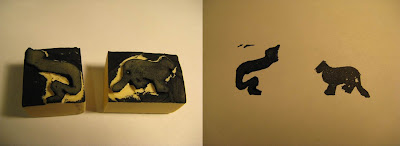Letterboxing is an old activity, somewhat related to both geocaching and orienteering. It involves navigating from a given starting point to a cached box containing a log book and a rubber stamp. Navigation consists of anything from following riddles and printed clues to compass directions and distances.
The low-tech nature of letterboxing is one of its attractions. You do not have to have a GPS device or any specialized equipment. A compass is really all you might need.
Once a letterbox is found, the letterboxer uses the stamp in the box to mark his log book and marks the box’s log book with his stamp. Each letterboxer also comes up with a trail name. The trail name coincides with your stamp identity and allows others to follow your hunts. Here is a picture of the stamps I made with the family. The cat is our family stamp and the snake is one my son drew for himself. I carved both of them out of a $1.26 art gum eraser.
 |
| Many letterboxers carve their own stamps. Here are my not so artistic attempts |
Once my seven year old son caught on that letterboxing was like going on a treasure hunt, he was easily convinced to learn the skills necessary to find the boxes. It only took him a minute to learn how to shoot a rough azimuth with my compass. I wrote out some basic directions including azimuths and number of paces from point to point throughout the house. He was successful in navigating through the house and finding a couple of baseball cards I had hidden for him.
I see letterboxing as a great way to introduce my younger children to the world of land navigation and location awareness. It might help them later to appreciate geocaching and orienteering which I would love to get them involved in.
The best place to find out more about letterboxing is Letterboxing.org. The site details history, etiquette, materials needed and rules of the game. More importantly it provides a list of letterbox cache sites and the instructions to find them. If there are no locations for your area, by all means go out and create some.